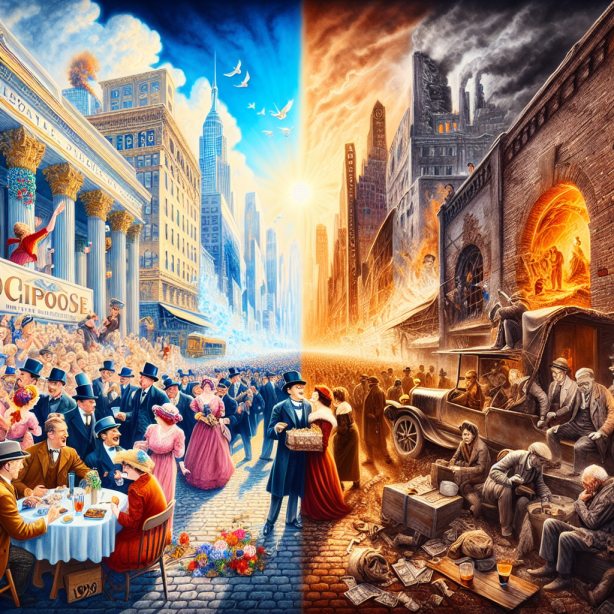
Which of the following is a cause of the stock market crash of 1929?
Update May 29, 2024
A Prelude to Chaos
The 1929 stock market crash was not a singular event but the result of a complex interplay of factors. The excesses of the Roaring Twenties, characterized by over-leveraged speculation and a misplaced belief in the perpetual rise of stock prices, set the stage for a dramatic correction. The Dow Jones Industrial Average’s meteoric rise to its September peak was a mirage of prosperity that could not sustain itself.
Oliver Cromwell might have recognized the hubris in the market’s relentless optimism, warning of the dangers of overconfidence and the need for a grounding in reality. Catherine the Great, a leader who navigated the treacherous waters of power, would likely have seen the crash as a failure to manage the excesses of success and the importance of prudent governance. Jesse Livermore, who profited from the crash, understood that markets are governed by human emotions as much as economic fundamentals and that recognizing the signs of collective greed or fear was crucial to navigating them successfully.
The crash was a stark reminder that prosperity is not a given and that the economy’s health reflects its underlying strengths and vulnerabilities. It was a lesson in the importance of regulatory oversight, the dangers of speculative excess, and the need for vigilance in monitoring the psychological temperature of the investing public.
Mass Psychology and The Illusion of Prosperity
In the heady days before 1929, the stock market was the canvas where dreams of affluence were painted, seemingly within everyone’s reach. This period, however, was not just about the tangible wealth it created but also about the psychological climate it fostered. The market’s ascent was steeped in a collective belief in its infallibility, a sentiment that Muzafer Sherif’s studies on social norms and influence could explain. The widespread conviction that stocks would only climb higher was a classic case of group conformity shaping individual perceptions of reality.
Gustave Le Bon’s insights into crowd behaviour illuminate how individual reasoning can be subsumed by the group, leading to the irrational exuberance that Robert Shiller later described. The market’s rise was a speculative bubble inflated by a collective delusion of unending prosperity, a mirage that was destined to dissipate.
With his astute understanding of human misjudgment, Charlie Munger would likely have seen the crash as inevitable due to widespread mental shortcuts and biases. The market’s participants, seduced by the narrative of perpetual growth, fell prey to what Munger might call ‘social-proof’ bias, where the rising market’s validation of their beliefs only reinforced them.
The 1929 crash, therefore, was not merely an economic event but a psychological phenomenon. It was a stark reminder of the perils of groupthink in financial decisions and the importance of maintaining individual critical thinking amidst market euphoria. As history teaches us, true prosperity is built not on the fragile foundations of mass optimism but on the solid ground of sound financial principles and disciplined investment strategies.
The Role of Credit
The Roaring Twenties, an era of economic boom and cultural flourish, also witnessed the stock market’s transformation into a beacon of rapid wealth accumulation. This surge was primarily propelled by the era’s liberal credit practices, particularly the widespread use of margin buying. Investors could now leverage borrowed funds to amplify their market positions, a strategy that magnified gains during market upswings but proved catastrophic during downturns.
Sigmund Freud might have seen this as a societal manifestation of a more profound psychological need for instant gratification, a collective expression of the pleasure principle where immediate rewards were pursued without regard to the potential long-term pain of loss and indebtedness.
Jerry Buss, known for his successful ownership of the Los Angeles Lakers and his keen business acumen, would likely have recognized the importance of a strong foundation for any enterprise, including the financial markets. He might have cautioned against the overextension of credit, emphasizing the need to balance ambition and economic prudence.
Bill Miller, a legendary investor known for beating the S&P 500 for 15 consecutive years, would understand the role of credit as a double-edged sword in investing. He might argue that while leverage can enhance returns, it must be used judiciously and with a clear-eyed assessment of the risks involved.
With his timeless investment philosophy, Warren Buffett would likely view the credit excesses of the 1920s as a deviation from intrinsic value-based investing. He has often warned against the dangers of high leverage, advocating for a margin of safety in investment practices.
The 1929 crash is a historical testament to the perils of over-leveraging and speculative excess. It underscores the importance of credit as a tool that should be wielded with caution and respect for its potential to build and destroy fortunes. True prosperity, as these thinkers might agree, is built on a foundation of sound financial principles, disciplined risk management, and an awareness of the psychological forces at play in the market.
The Domino Effect
The 1929 stock market crash was a domino effect exacerbated by the lack of financial regulation. In an era where the market was a new frontier, the absence of rules allowed unchecked speculation and risky credit practices, such as buying on margin. This created a precarious financial environment where the illusion of wealth was built on a fragile foundation of debt.
John Templeton, known for his contrarian investment approach, might have seen this as an opportunity to advocate for the wisdom of looking beyond the crowd. He believed in the value of thorough analysis and foresight, which were sorely missing in the pre-crash market frenzy.
Kirk Kerkorian, a business magnate who thrived in volatile industries like aviation and casinos, understood the importance of calculated risk-taking. He might have viewed the crash as a failure to assess risks accurately and underestimating the market’s complexity.
Philip Zimbardo’s research into the psychology of human behaviour, including the ‘Lucifer Effect’ concept, explores how good people can turn evil under certain conditions, which could be applied to the market’s situation. The lack of regulation may have facilitated a psychological environment where normally cautious individuals were drawn into the mania of speculation.
The aftermath of the crash led to the establishment of the Securities and Exchange Commission in 1934, aiming to restore trust in the market. This regulatory body was a step towards preventing the speculative excess that led to the crash, promoting transparency and protecting investors from the darker aspects of market psychology.
Financial crises often involve tangible factors like credit, speculation, and regulation. Yet, human psychology, as emphasized by investment luminaries like Charlie Munger and Peter Lynch, is a crucial yet overlooked element. Nobel laureate Daniel Kahneman highlights the impact of psychology on financial decisions.
During market highs, greed drives investors to risky ventures, which Munger and Lynch caution against. Conversely, fear prompts panicked selling in downturns, further exacerbated by herd mentality. Understanding and managing psychological biases, as advocated by Munger and Lynch, is critical to successful investing.
In essence, behavioural economics underscores the need for emotional discipline and self-awareness in financial decision-making, emphasizing the importance of mastering one’s emotions for long-term prosperity.
The Aftermath, Insights, and Lessons Carved in Time
The 1929 stock market crash stands as a stark lesson in the annals of financial history, a testament to the consequences of speculative excess and the absence of regulatory oversight. The Great Depression that followed reshaped financial markets and the global socio-economic landscape, leaving a legacy of insights and lessons that remain relevant today.
Warren Buffett, one of the greatest investors of all time, would likely point to the crash as a clear example of his principle that one should be fearful when others are greedy. His investment philosophy emphasizes the importance of understanding intrinsic value and maintaining a margin of safety, notably absent during the speculative bubble that led to the crash.
With his sharp wit and multidisciplinary approach, Charlie Munger, Buffett’s long-time business partner, would probably highlight the psychological pitfalls investors faced in 1929. He has often spoken about the importance of avoiding the herd mentality and the lure of easy money, which aligns with the missteps that led to the market’s downfall.
Benjamin Graham, known as the father of value investing, would have seen the crash as a vindication of his investment principles. These principles advocate for thorough analysis and the pursuit of investments that are undervalued by the market. Graham’s teachings underscore the dangers of speculative investment strategies that ignore the underlying value of securities.
Nikola Tesla, renowned for his mastery of electricity and electromagnetism, could have seen parallels between energy principles and the 1929 stock market crash. He might have compared the inflated market to a capacitor overcharged with wealth, destined to discharge when disconnected from the reality of tangible assets. Tesla’s recognition of systemic balance and the risk of destabilizing forces in natural systems could mirror the financial chaos caused by speculative fervour and irresponsible credit use. His respect for natural laws may have warned against the economic overreach that precipitated the crash, underscoring the need for equilibrium in financial and physical systems.
Aristotle, one of the greatest philosophers, would have contributed a valuable perspective on the ethical considerations of financial dealings and the role of moderation. His virtue ethics could guide the balanced approach needed in investment, avoiding the extremes of fear and greed that characterized the pre-crash era.
Plato, another eminent philosopher, might have used the cave allegory to describe the illusionary nature of the wealth generated in the stock market bubble. He would advocate for the pursuit of true knowledge and understanding instead of the shadows of wealth and success that led investors astray.
The aftermath of the crash, with its profound and lasting effects, serves as a reminder of the importance of financial literacy, the need for robust regulatory frameworks, and the value of a disciplined, ethical approach to investing. These lessons, carved by the experiences of some of the best minds in investing and philosophy, continue to illuminate the path for investors seeking to navigate the complexities of the financial markets.
Tasty Treats
Avoiding Debt: Paving the Path to Financial Freedom and Hope












